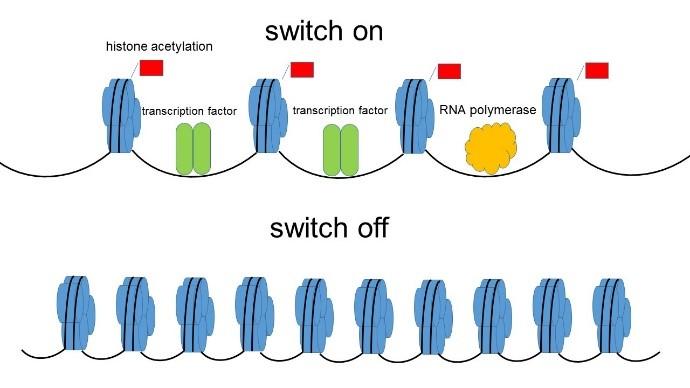The discovery of a totally new kind of 'mark' in human cell nucleus

Fig. 1 Histone Acetylation It was accepted that histone acetylation modifications are implicated only in gene activation "switch on". Credit: Osaka University
A Japanese research group verified the presence of a protein modification that is a unique mark in human cell nucleus. This protein modification, Histone H4 lysine 20 acetylation (H4K20ac), was only discovered in plant cells and its existence in mammalian cells has been indirectly proven.
Their study suggests that H4K20ac is associated with gene repression. This new discovery of H4K20ac may lead to further clarification of the mechanisms in disease progression.
In recent years, it has been known that epigenetic factors, factors outside of the genetic sequence, are deeply involved in the development of various diseases. Histone, a component of chromatin consisting of DNA, receives post-translational modification for changing the function of protein as an epigenetic factor.
It was accepted that histone acetylation modifications are implicated only in gene activation,”switch on” (Fig. 1).
A research group was led by Yoshitaka Isaka, professor, and Shiro Takahara, endowed chair professor, and Junya Kaimori, endowed chair professor at the Graduate School of Medicine together with Toshifumi Takao, professor at the Institute for Protein Research, Osaka University, Hiroshi Kimura, professor at the Graduate School of Bioscience and Biotechnology, Tokyo Institute of Technology, and Professor Yasuyuki Okawa, professor at Medical Institute of Bioregulation, Kyushu University.
This group made antibodies against H4K20ac. Although known acetyliation was enriched around promoters of highly expressed genes, this group, by using a chromatin immunoprecipitation method, next-generation sequencing, and supercomputers, found that H4K20ac, a new type of histone modification, was enriched around promoters of minimally expressed genes (Fig. 2 and Fig. 3.).
It is expected that the mechanism of development of various diseases such as metabolic disorders including diabetes, cardiovascular diseases including cardiomegaly, kidney disorders, and cancer will be elucidated by using H4K20ac, a new type of histone modification discovered by this group.
This research was featured in the electronic version of Scientific Reports on Monday, April 11, 2016.
Media Contact
All latest news from the category: Life Sciences and Chemistry
Articles and reports from the Life Sciences and chemistry area deal with applied and basic research into modern biology, chemistry and human medicine.
Valuable information can be found on a range of life sciences fields including bacteriology, biochemistry, bionics, bioinformatics, biophysics, biotechnology, genetics, geobotany, human biology, marine biology, microbiology, molecular biology, cellular biology, zoology, bioinorganic chemistry, microchemistry and environmental chemistry.
Newest articles

NASA: Mystery of life’s handedness deepens
The mystery of why life uses molecules with specific orientations has deepened with a NASA-funded discovery that RNA — a key molecule thought to have potentially held the instructions for…

What are the effects of historic lithium mining on water quality?
Study reveals low levels of common contaminants but high levels of other elements in waters associated with an abandoned lithium mine. Lithium ore and mining waste from a historic lithium…

Quantum-inspired design boosts efficiency of heat-to-electricity conversion
Rice engineers take unconventional route to improving thermophotovoltaic systems. Researchers at Rice University have found a new way to improve a key element of thermophotovoltaic (TPV) systems, which convert heat…



